Day Trading Encyclopedia
Charts Candlestick Charts
Candlestick Charts
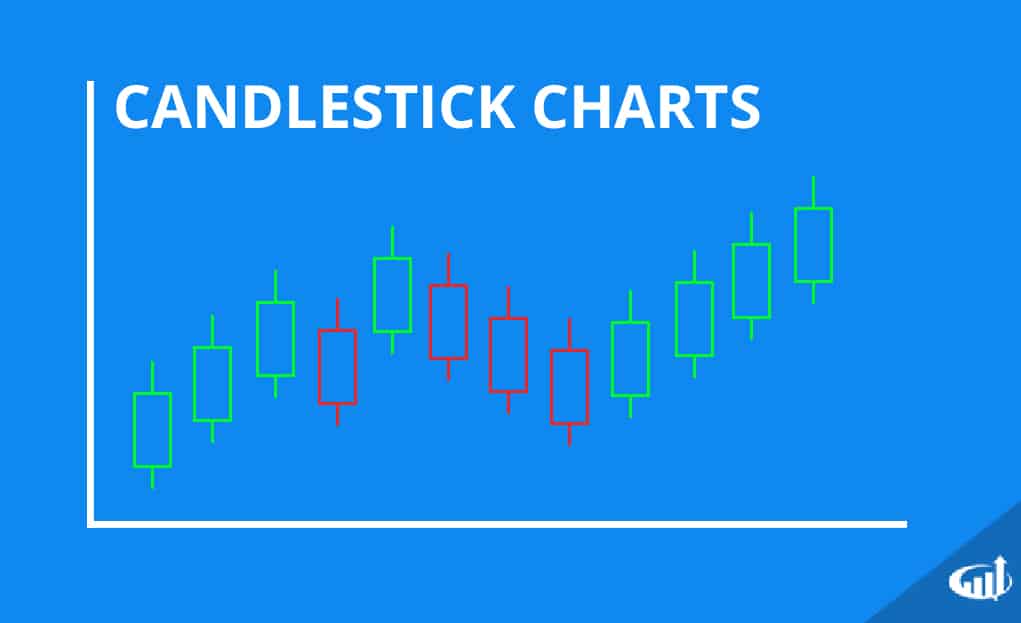
Candlestick Charts
History of Candlestick Charts
The creation of candlestick charts is widely credited to an 18th-century Japanese rice trader, Munehisa Homma. His prowess at gaming the rice trading markets was legendary. It is believed his candlestick methods were further modified and adjusted through the ages to become more applicable to current financial markets. Steven Nison introduced candlesticks to the Western world with his book “Japanese Candlestick Charting Techniques”. Candlesticks have become a staple of every trading platform and charting program for literally every financial trading vehicle. The depth of information and the simplicity of the components make candlestick charts a favorite among traders. The ability to chain together many candlesticks to reveal an underlying pattern makes it a compelling tool when interpreting price action history and forecasts.
How to Read Candlestick Charts
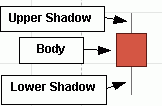
Basic Candle Formation
A candlestick is composed of three parts: the upper shadow, lower shadow, and body. The body is colored green or red. Each candlestick represents a segmented period of time. The candlestick data summarizes the executed trades during that specific period of time. For example a 5-minute candle represents 5 minutes of trades data. There are four data points in every candlestick: the open, high, low and close. The open is the very first trade for the specific period and the close is the very last trade for the period. The open and close is considered the body of the candle. The high is the highest priced trade and low is the lowest price trade for that period.
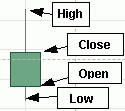
How to Read a Candlestick
The high is represented by a vertical line extending from the top of the body to the highest price called a shadow, tail, or wick. The low of the candle is the lower shadow or tail, represented by a vertical line extending down from the body. If the close is higher than the open, then the body is colored green representing a net price gain. If the open is higher than the close, then the body is colored red as it represents a net price decline.
Charting and Technical Analysis Course
Check out the technical analysis chapter from our free trading course to learn more about proper charting techniques and technical analysis
Candlestick Chart Patterns
Every candlestick tells a story of the showdown between the bulls and the bears, buyers and sellers, supply and demand, fear and greed. It is important to keep in mind that most candle patterns need a confirmation based on the context of the preceding candles and proceeding candle. Many newbies make the common mistake of spotting a single candle formation without taking the context into consideration. For example, a hammer candle represents a near-term capitulation bottom if it forms after three preceding bearish candles, whereas hammer candle that forms on ‘flat’ sideways candles is basically useless. Therefore it pays to understand the ‘story’ that each candle represents in order to attain a firm grasp on the mechanics of candlestick chart patterns. These patterns tend to repeat themselves constantly, but the market will just as often try to fake out traders in the same vein when the context is overlooked. Candlestick charts tend to represent more emotion due to the coloring of the bodies. It’s prudent to make sure they are incorporated with other indicators to achieve best results. The following are some of common candlestick reversal patterns.
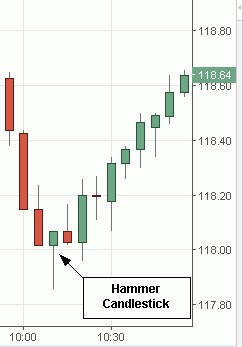
Hammer Candlestick
Hammer Candlestick
The hammer is a bullish reversal candlestick. It is one of the most (if not the most) widely followed candlestick pattern. It is used to determine capitulation bottoms followed by a price bounce that traders use to enter long positions.
A hammer candlestick forms at the end of a downtrend and indicates a near-term price bottom. The hammer candle has a lower shadow that makes a new low in the downtrend sequence and then closes back up near or above the open. The lower shadow (also called a tail) must be at least two or more times the size of the body. This represents the longs that finally threw in the towel and stopped out as shorts start covering their positions and bargain hunters come in off the fence. A volume increase also helps to solidify the hammer. To confirm the hammer candle, it is important for the next candle to close above the low of the hammer candle and preferably above the body. A typical buy signal would be an entry above the high of the candle after the hammer with a trail stop either beneath the body low or the low of the hammer candle. It is prudent to time the entry with a momentum indicator like a MACD, stochastic or RSI.
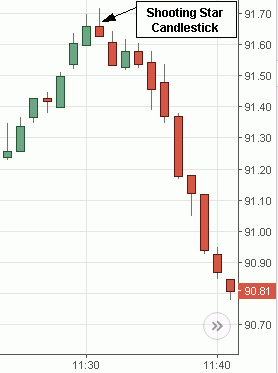
Shooting Star Candlestick
Shooting Star Candlestick
The shooting star is a bearish reversal candlestick indicating a peak or top. It is the exact inverse version of a hammer candle. The star should form after at least three or more subsequent green candles indicating a rising price and demand. Eventually, the buyers lose patience and chase the price to new highs (of the sequence) before realizing they overpaid.
The upper shadow (also known as a wick) should generally be twice as large as the body. This indicates the last of the frenzied buyers have entered the stock just as profit takers unload their positions followed by short-sellers pushing the price down to close the candle near or below the open. This in essence, traps the late buyers who chased the price too high. Fear is at the highest point here as the very next candle should close at or under the shooting star candle, which will set off a panic selling spree as late buyers panic to get out and curb losses. The typical short-sell signal forms when the low of the following candlestick price is broken with trail stops at the high of the body or tail of the shooting star candlestick.
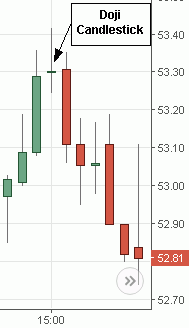
Doji Candlestick
Doji Candlestick
The doji is a reversal pattern that can be either bullish or bearish depending on the context of the preceding candles. The candle has the same (or close to) open and closing price with long shadows. It looks like a cross, but it can also have a very tiny body. A doji is a sign of indecision but also a proverbial line in the sand. Since the doji is typically a reversal candle, the direction of the preceding candles can give an early indication of which way the reversal will go.
If the preceding candles are bullish before forming the doji, the next candle close under the body low triggers a sell/short-sell signal on the break of the doji candlestick lows with trail stops above the doji highs.
If the preceding candles are bearish then the doji candlestick will likely form a bullish reversal. Long triggers form above the body or candlestick high with a trail stop under the low of the doji.
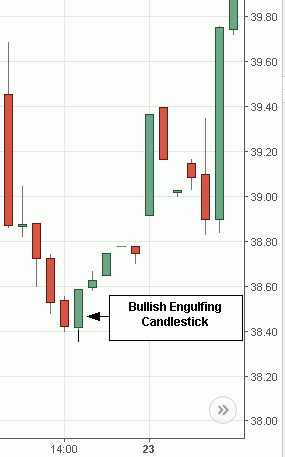
Bullish Engulfing Candlestick
Bullish Engulfing Candlestick
A bullish engulfing candlestick is a large bodied green candle that completely engulfs the full range of the preceding red candle. The larger the body, the more extreme the reversal becomes. The body should completely engulf the preceding red candle body.
The most effective bullish engulfing candlesticks form at the tail end of a downtrend to trigger a sharp reversal bounce that overwhelms the short-sellers causing a panic short covering buying frenzy. This motivates bargain hunters to come off the fence further adding to the buying pressure. Bullish engulfing candles are potential reversal signals on downtrends and continuation signals on uptrends when they form after a shallow reversion pullback. The volume should spike to at least double the average when bullish engulfing candles form to be most effective. The buy trigger forms when the next candlestick exceeds the high of the bullish engulfing candlestick.
Bearish Engulfing Candlestick
Like a massive tidal wave that completely engulfs an island, the bearish engulfing candlestick completely swallows the range of the preceding green candlestick. This is a strong price reversal candlestick. The bearish engulfing candlestick body eclipses the body of the prior green candle. Even stronger bearish engulfing candlesticks will have bodies that consume the full preceding candlestick including the upper and lower shadows. These candlesticks can be signs of enormous selling activity on a panic reversal from bullish to bearish sentiment.
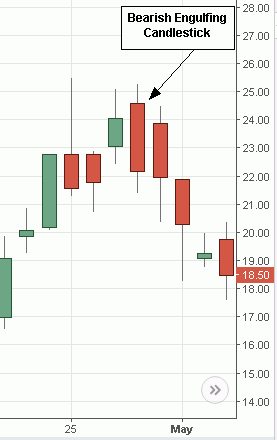
Bearish Engulfing Candlestick
The preceding green candle keeps unassuming buyers optimism, as it should be trading near the top of an up trend. The bearish engulfing candle will actually open up higher giving longs hope for another climb as it initially indicates more bullish sentiment. However, the sellers come in very strong and extreme fashion driving down the price through the opening level, which starts to stir some concerns with the longs. The selling intensifies as the price falls through the low of the prior close, which then starts to trigger some more panic selling as the majority of buyers from the prior day are now underwater on their shares. The selling intensifies into the candle close as almost every buyer from the prior close is now holding losses. The magnitude of the reversal is dramatic. The bearish engulfing candle is reversal candle when it forms on uptrends as it triggers more sellers the next day and so forth as the trend starts to reverse into a breakdown. The short-sell trigger forms when the next candlestick exceeds the low of the bullish engulfing candlestick. On existing downtrends, the bearish engulfing may form on a reversion bounce thereby resuming the downtrends at an accelerated pace due to the new buyers that got trapped on the bounce. As with all candlestick patterns, it is important to observe the volume especially on engulfing candles. The volume should be at least two or more times larger than the average daily trading volume to have the most impact. Algorithm programs are notorious for painting the tape at the end of the day with a mis-tick to close out with a fake engulfing candle to trap the bears.
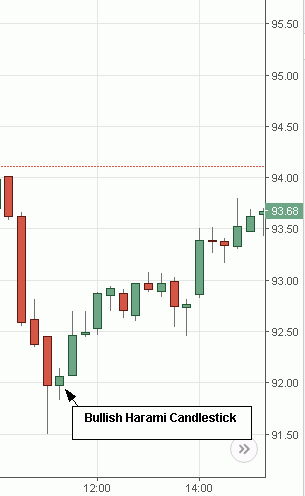
Bullish Harami Candlestick
Bullish Harami Candlestick
A bullish harami candle is like a backwards version of the bearish engulfing candlestick pattern where the large body engulfing candle actually precedes the smaller harami candle. The preceding engulfing red candle should be a capitulation large body candlestick that makes the lowest low point of the sequence indicating a capitulation sell-off preceding the harami candle which should trading well within the range of the engulfing candle. The subtleness of the small body keeps the short-sellers in a complacent mode as they assume the stock will drop again, but instead it stabilizes before forming a reversal bounce that takes the short-seller by surprise as the stock reverses back up.
The harami is a subtle clue that often keeps sellers complacent until the trend slowly reverses. It is not as intimidating or dramatic as the bullish engulfing candle. The subtleness of the bullish harami candlestick is what makes it very dangerous for short-sellers as the reversal happens gradually and then accelerates quickly. A buy long trigger forms when the next candle rises through the high of the prior engulfing candle and stops can be placed under the lows of the harami candle.
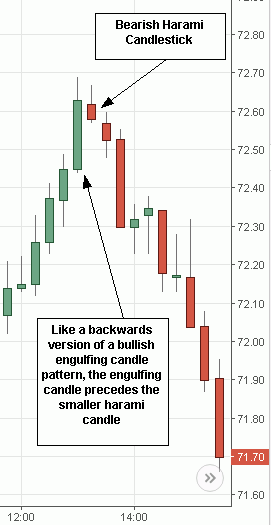
Bearish Harami Candlestick
Bearish Harami Candlestick
The bearish harami is the inverted version of the bullish harami. The preceding engulfing candle should completely eclipse the range of the harami candle, like David versus Goliath. These form at the top of uptrends as the preceding green candle makes a new high with a large body, before the small harami candlestick forms as buying pressure gradually dissipates. Due to the gradual nature of the buying slow down, the longs assume the pullback is merely a pause before the up trend resumes.
As the bearish harami candlestick closes, the next candle closes lower which starts to concern the longs. When the low of the preceding engulfing candle broken, it triggers a panic sell-off as longs run for the exits to curtail further losses. The conventional short-sell triggers form when the low of the engulfing candle is breached and stops can be placed above the high of the harami candlestick.
Hanging Man Candlestick
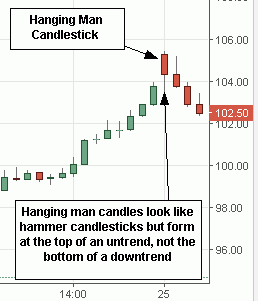
Hanging Man Candlestick
A hanging man candlestick looks identical to a hammer candlestick but forms at the peak of an uptrend, rather than a bottom of a downtrend. The hanging man has a small body, lower shadow that is larger than the body (preferably twice the size or more) and a very small upper shadow. It is differs from a doji since it has a body that is formed at the top of the range. For some reason, the buyers thwarted a potential shooting star and lifted the candle to close at the upper range of the candle to maintain the bullish sentiment, often times artificially. However, the truth hits when the next candle closes under the hanging man as selling accelerates.
Hanging man candles are most effective at the peak of parabolic like price spikes composed of four or more consecutive green candles. Most bearish reversal candles will form on shooting stars and doji candlesticks. Hanging man candles are uncommon as they are a sign of a large buyer that gets trapped trying to support the momentum or an attempt the paint the tape to generate more liquidity to sell into.
A hanging man candlestick signals a potential peak of an uptrend as buyers who chased the price look down and wonder why they chased the price so high. It brings to mind the old road runner cartoons where Wile E. Coyote would be chasing the Road Runner and before he knew it, he realized he overstepped the cliff when he looks down, right before he plunges.
Short-sell triggers signal when the low of the hanging man candlestick is breached with trail stops placed above the high of the hanging man candle.
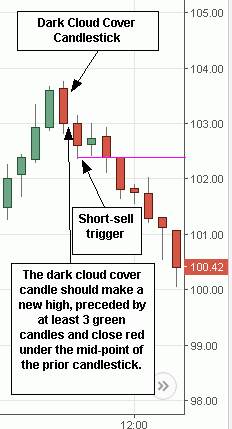
Dark Cloud Cover Candlestick
Dark Cloud Cover Candlestick
This is actually a three candlestick reversal formation where the dark cloud cover candle will actually make a new high of the uptrend sequence as it gaps above the prior candle close, but ends up closing red as sellers step in early. This indicates that longs were anxious to take proactive measure and sell their positions even as new highs were being made. Dark cloud cover candles should have bodies that close below the mid-point of the prior candlestick body. This is what distinguishes from a doji, shooting star or hanging man bearish reversal pattern. The prior candle, dark cloud candle and the following confirmation candle compose the three-candle pattern. The preceding candlesticks should be at least three consecutive green candles leading up the dark cloud cover candlestick.
The selling overwhelms and traps the new buyers. If the next candle fails to make a new high (above the dark cloud cover candlestick) then it sets up a short-sell trigger when the low of the third candlestick is breached. This opens up a trap door that indicates panic selling as longs evacuate the burning theater in a frenzied attempt to curtail losses. Short-sell signals trigger when the low of the third candle is breached, with trail stops set above the high of the dark cloud cover candle.
